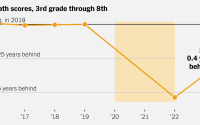At the Defense Table, Trump Uses the Courtroom as a Stage
He shook his head in anger, sitting with his back hunched. He spoke to his lawyers, his words sometimes quite audible to the packed courtroom. He wrote instructions for his defense team that he shoved their way. He walked in late at one point, and at another, while a lawyer suing him was speaking to the jury, he stalked out.
Former President Donald J. Trump’s behavior as he attended the defamation trial that ended on Friday with a jury ordering him to pay $83.3 million to the writer E. Jean Carroll — and his similar conduct in a pending civil case in New York — showcased his disdain both for a legal system seeking to hold him accountable and for the protocols of courtrooms where he has little control.
His use of the defense table as a stage also provided clues to the public, and a reminder to his own legal team, of how he might handle himself if and when any of the four criminal cases he is facing go to trial. In all of those cases he will be required to be present throughout the proceedings, unlike in the Carroll case or the New York attorney general’s case accusing him of business fraud, both civil trials in which he was free to attend or not as he wished.
Even as he was moving toward wrapping up the Republican presidential nomination, Mr. Trump appeared at five days of the Carroll trial in the cavernous, wood-paneled federal courtroom in Manhattan of Judge Lewis A. Kaplan, a veteran, no-nonsense jurist who has handled notable terrorism cases. And in recent months he sat for many days of the trial a few blocks away at 60 Centre Street, where Justice Arthur F. Engoron of State Supreme Court oversaw the fraud trial against Mr. Trump and his company.
Mr. Trump, who has long conflated legal problems with public relations problems, quickly sought to use both courtrooms to get across his own message in the midst of his presidential campaign, a tactic that created a tense environment.
At times in both trials, the stress on him, and his anger at allegations that cut to the heart of his character and his public persona as a billionaire business magnate, seemed to show. Mr. Trump fidgeted throughout his time in court last week. He readjusted his tie. He looked at his hands. He leaned back in his seat, then forward, then back. A few times, he smoothed down the back strands of his hair rising over his suit collar.
Yet he was attentive at specific points, particularly when he seemed to be trying to communicate something either to jurors or to the dozens of reporters watching the proceedings in the courtroom.
During jury selection, he looked at all the potential jurors as they walked into the courtroom and pivoted in his seat to get a better view as they answered biographical questions posed by the court.
Throughout the trial, Mr. Trump scanned the jurors’ faces. A few times he smiled at them.
He was far less solicitous whenever Judge Kaplan described Mr. Trump as having sexually abused Ms. Carroll as a matter of fact that was established by a previous jury. When Judge Kaplan described Mr. Trump as having “ “forcibly” penetrated Ms. Carroll, who accused Mr. Trump of raping her in a department store dressing room decades ago, the former president made a loud “yech” sound.
Mr. Trump, who sees himself as his own best communicator and defender, sat next to his lawyers at both trials, whispering and writing notes to them. Before Ms. Carroll’s lawyers played a video that Mr. Trump posted on Truth Social, Alina Habba, his lead lawyer, told the court that she wanted the entire video to be “submitted.” Mr. Trump looked at her and said “and played” loud enough for the courtroom to hear. Ms. Habba immediately added, “And played.”
During Ms. Carroll’s testimony, Mr. Trump continuously scoffed, whispered to his defense team and shook his head over two dozen times as she spoke, including as she described the impact of the negative social media messages from Trump supporters. At one point, when describing her response to a message that said “stick a gun in your mouth and pull the trigger,” Ms. Carroll’s voice trembled. Mr. Trump shook his head.
Judge Kaplan, who has a reputation for being stern about what he permits in his courtroom, was often harsh toward Ms. Habba, threatening on the last day to put her in “lockup.” Yet despite Mr. Trump’s insistence that he is being treated unfairly, Judge Kaplan gave him considerable latitude.
Mr. Trump’s grumblings during Ms. Carroll’s testimony prompted Judge Kaplan to raise the possibility of tossing him from the courtroom, saying he knew Mr. Trump wanted that. “I would love it. I would love it,” Mr. Trump said.
When the judge told Mr. Trump that he apparently couldn’t control himself, the defendant replied, “Neither can you.” There was no further rebuke by the judge, who was plainly mindful that the trial was playing out in a charged political context.
Mr. Trump seemed intent on finding a way to make his own case, despite the limits imposed by the court. At one point, when Ms. Carroll’s lawyers played a clip of Mr. Trump calling Ms. Carroll’s allegations a “made-up story,” Mr. Trump said “true,” loudly enough for the courtroom to hear.
He mouthed the word “true” at another point, when one of Ms. Carroll’s lawyers, during closing arguments, said that Mr. Trump’s legal team wanted the jury to believe he was the real victim.
When he testified in the fraud case brought by the New York attorney general, Letitia James, in state court, Mr. Trump called the trial “very unfair,” said that Ms. James was a “political hack” and insulted Justice Engoron, saying that “the fraud is on the court.”
Going into the Carroll defamation trial, Mr. Trump had been warned by his lawyers that Judge Kaplan, in a federal courthouse, would tolerate far less than Justice Engoron had, in part because there was no jury in the civil New York fraud case. Yet Mr. Trump still pressed the boundaries of what he could get away with when he briefly took the stand in his own defense by making comments that the judge quickly struck from the record.
One of the most dramatic moments of the Carroll case came while Ms. Carroll’s lead lawyer, Roberta A. Kaplan, delivered her closing arguments excoriating Mr. Trump for continuing to defame her client even after being found guilty of such conduct at the earlier trial.
“Even if you don’t like a jury’s decision, you are supposed to follow it,” Ms. Kaplan said. “Those are the rules. This doesn’t depend on your politics, it doesn’t depend on who you vote for or whether you support a particular policy or a particular party. We all have to follow the law. Donald Trump, however, acts as if these rules and laws just don’t apply to him.”
As Ms. Kaplan moved on to her next few sentences, Mr. Trump pushed his chair back, stood up, walked to the back of the courtroom and out the doors. The judge noted that Mr. Trump had departed.
Outside the courtroom, his eruption briefly overshadowed proceedings in media coverage, which may have been the goal. But it was short-lived. Within hours, the headlines captured Mr. Trump’s new reality: the jury’s judgment that he owes Ms. Carroll $83.3 million.


